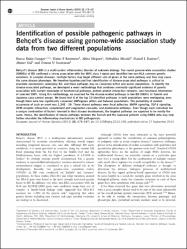| dc.contributor.author | Bakir-Gungor, Burcu | |
| dc.contributor.author | Remmers, Elaine F. | |
| dc.contributor.author | Meguro, Akira | |
| dc.contributor.author | Mizuki, Nobuhisa | |
| dc.contributor.author | Kastner, Daniel L. | |
| dc.contributor.author | Gul, Ahmet | |
| dc.contributor.author | Sezerman, Osman U. | |
| dc.date.accessioned | 2020-02-04T11:22:19Z | |
| dc.date.available | 2020-02-04T11:22:19Z | |
| dc.date.issued | 2015 | en_US |
| dc.identifier.issn | 1018-4813 | |
| dc.identifier.other | 1476-5438 | |
| dc.identifier.other | 10.1038/ejhg.2014.158 | |
| dc.identifier.uri | https://hdl.handle.net/20.500.12573/117 | |
| dc.description | This work was supported by the Intensified Cooperation (IntenC): Promotion of German-Turkish Higher Education Research Grant of The Scientific and Technological Research Council of Turkey (TUBITAK; 109S218). The Abdullah Gul University Support Foundation (AGUV) supported the work of BB-G. | en_US |
| dc.description.abstract | Behcet's disease (BD) is a multi-system inflammatory disorder of unknown etiology. Two recent genome-wide association studies (GWASs) of BD confirmed a strong association with the MHC class I region and identified two non-HLA common genetic variations. In complex diseases, multiple factors may target different sets of genes in the same pathway and thus may cause the same disease phenotype. We therefore hypothesized that identification of disease-associated pathways is critical to elucidate mechanisms underlying BD, and those pathways may be conserved within and across populations. To identify the disease-associated pathways, we developed a novel methodology that combines nominally significant evidence of genetic association with current knowledge of biochemical pathways, protein-protein interaction networks, and functional information of selected SNPs. Using this methodology, we searched for the disease-related pathways in two BD GWASs in Turkish and Japanese case-control groups. We found that 6 of the top 10 identified pathways in both populations were overlapping, even though there were few significantly conserved SNPs/genes within and between populations. The probability of random occurrence of such an event was 2.24E -39. These shared pathways were focal adhesion, MAPK signaling, TGF-beta signaling, ECM-receptor interaction, complement and coagulation cascades, and proteasome pathways. Even though each individual has a unique combination of factors involved in their disease development, the targeted pathways are expected to be mostly the same. Hence, the identification of shared pathways between the Turkish and the Japanese patients using GWAS data may help further elucidate the inflammatory mechanisms in BD pathogenesis. | en_US |
| dc.description.sponsorship | Turkiye Bilimsel ve Teknolojik Arastirma Kurumu (TUBITAK) 109S218 Abdullah Gul University | en_US |
| dc.language.iso | eng | en_US |
| dc.publisher | NATURE PUBLISHING GROUP, MACMILLAN BUILDING, 4 CRINAN ST, LONDON N1 9XW, ENGLAND | en_US |
| dc.relation.ispartofseries | Volume: 23; | |
| dc.relation.ispartofseries | Issue: 5; | |
| dc.relation.ispartofseries | Pages: 678-687; | |
| dc.rights | info:eu-repo/semantics/openAccess | en_US |
| dc.subject | SUSCEPTIBILITY LOCI | en_US |
| dc.subject | T-CELLS | en_US |
| dc.subject | VARIANTS | en_US |
| dc.subject | COAGULATION | en_US |
| dc.subject | ACTIVATION | en_US |
| dc.subject | IL23R-IL12RB2 | en_US |
| dc.subject | MUTATIONS | en_US |
| dc.subject | RISK | en_US |
| dc.subject | TH17 | en_US |
| dc.title | Identification of possible pathogenic pathways in Behcet's disease using genome-wide association study data from two different populations | en_US |
| dc.type | article | en_US |
| dc.contributor.department | AGÜ, Mühendislik Fakültesi, Bilgisayar Mühendisliği Bölümü | en_US |
| dc.contributor.institutionauthor | | |
| dc.identifier.doi | 10.1038/ejhg.2014.158 | |
| dc.relation.publicationcategory | Makale - Uluslararası Hakemli Dergi - Kurum Öğretim Elemanı | en_US |


















